One of my least favorite books about hitting is "The Louisville Slugger Complete Book of Hitting Faults and Fixes." The reason why I think this book is so terrible is that the authors have no idea what a good swing actually looks like. As a result, they think flaws are good things to do and, even worse, they label as flaws things that are actually good.
That is a problem because it means that, not only will hitters be coached into bad mechanics, they will be coached out of good mechanics.
Let's discuss some of these phony flaws.
Alligator Arms
Proponents of Extension at the Point of Contact tend to talk about a flaw called Alligator Arms where the hitter's arms, instead of being at full extension at the Point Of Contact, are close to the body with the elbows close to or even touching the body. The problem is that it's very easy to find pictures of hitters hitting home runs while demonstrating Alligator Arms, and that is because Alligator Arms are a reflection of Compactness.
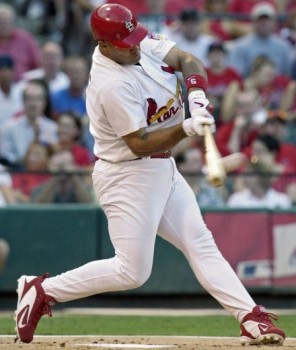
Albert Pujols
Just last night I was listening to a broadcast and heard the announcer talk about how a hitter hit a weak pop-up because he had to pull his arms in (and, presumably, because he wasn't able to get extended).
Unfortunately, what he said doesn't match up with reality.
In fact, most of the most vicious foul balls -- the really nasty line drives that are the most likely to hurt people -- occur precisely when the hitter gets a pitch inside and pulls his hands in toward himself. Pulling the hands in hard causes the barrel to Whip around especially forcefully and usually results in a pull-hook.[1]
In truth, the reason why hitters often hit weak pop-ups on pitches inside isn't because they pull their hands in, but because they can't pull their hands in far enough.
If you look at jammed pop-ups on video, in most cases what you will see is that the ball hits off of the taper of the barrel. That is because the hitter wasn't able to pull their hands in enough to hit the ball off the sweet spot of the bat.
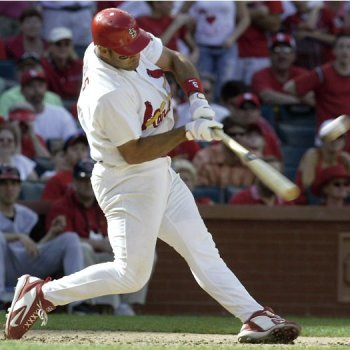
Albert Pujols
The picture above of Albert Pujols hitting a home run is a perfect example of what I am talking about; this is a classic Alligator Arms position, yet the result of the swing was still a home run. Albert Pujols was able to pull his arms in and keep the sweet spot of the barrel into the path of the ball. He was able to keep this ball fair because, rather than casting, he stayed Compact as he rotated. As a result, he didn't have to pull his hands in so much that he pull-hooked the ball.
Bat Wrap
Wrapping the Barrel
Many coaches teach that wrapping the barrel is a problem. While you can certainly take it too far, the fact is that you can see Bat Wrap in the swings of many good hitters.
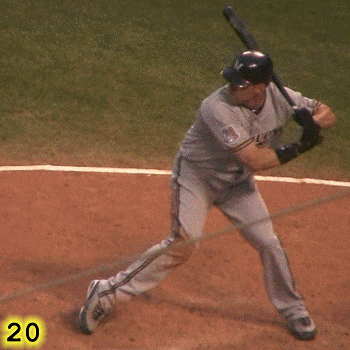
Jim Edmonds' Bat Wrap
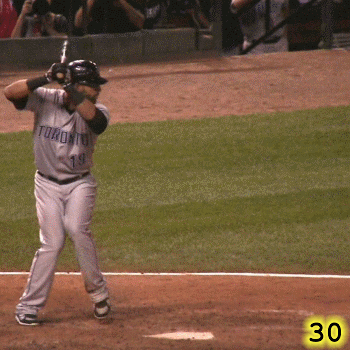
Jose Bautista's Bat Wrap
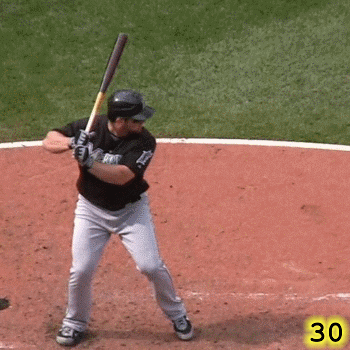
Dan Uggla's Bat Wrap
Presumably, they do it as a part of the Loading process and as a way of helping to create Separation, which has to make you wonder if Bat Wrap is really as big of a problem as people think. It should also make you wonder if, in trying to solve a "problem" with Bat Wrap coaches are inadvertently hindering their hitters' abilities to load.
Chicken Wing
A related flaw that Tony Gwynn rails against is what he calls the chicken wing, which he says can create a Loop in the swing.
However, what he says is a problem does hold up to close scrutiny.
First, the hitter's front elbow has to work around on every pitch -- and around and up on pitches down in the strike zone -- because that is the key to maintaining Alignment and not Dropping the Hands. Second, the front elbow has to bend in order to enable the hitter to adjust and hit an inside pitch.[2]
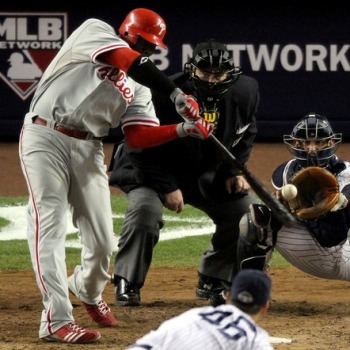
Ryan Howard's Chicken Wing
Ryan Howard was able to hit the ball out of the park precisely because he kept his front elbow up and dropped the barrel. That let the barrel rotate in the plane of his shoulders, which is very efficient.
Dipping/Dropping the Barrel
This phony flaw presumably goes along with the myths of the Level Swing, Keeping the Barrel Above the Ball, and the general idea that a Loop in the Swing is a bad thing. The problem with this phony flaw is that it will often lead a hitter to chop down on the ball and will keep them from tilting to adjust to pitches down in the strike zone. That why I have literally never seen a picture hitting a ball without dipping/dropping the barrel.
Diving Over the Plate
While it's certainly possible to dive forward over the plate, leaving yourself vulnerable to pitches inside, in most cases what is labeled as "Diving over the plate," is actually Tilt.
Dropping the Back Shoulder
In most cases, older hitters who appear to be dropping their back shoulders are really just Tilting to adjust to the height of the pitch. If you teach them to not drop their back shoulder, then you are likely going to create a problem with Dropping the Hands (because the only way to cover the bottom third of the strike zone while keeping the shoulders level is to Drop the Hands). You will also see hitters who swing with a Slight Uppercut drop their back shoulder a bit.
Only in relatively rare occasions, and usually only with younger hitters (e.g. hitters below high school age) will dropping the back shoulder be related to an actual problem like an Excessive Uppercut.
Hitch
While it is possible to get the hands up too late, in many if not most cases people are confusing a Running Start, a Resisting Movement, or another means of Loading and creating Separation with a Hitch. As a result, they are robbing their hitters of power (and often average because you have to hit the ball hard to get hits).
Loop
One thing that Tony Gwynn rails against is a flaw that he calls a Loop or Reverse C.[3] By "Loop" he means the bat head dropping below the hands. While a Loop is supposed to cause pop-ups, in truth every good hitter, including Tony Gwynn, has just such a Loop in their swing. That is because a Loop in the Swing is the result of swinging with a Slight Uppercut.
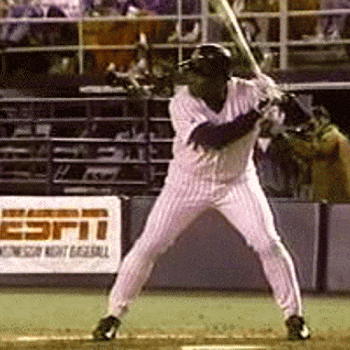
The Loop in Tony Gwynn's Swing
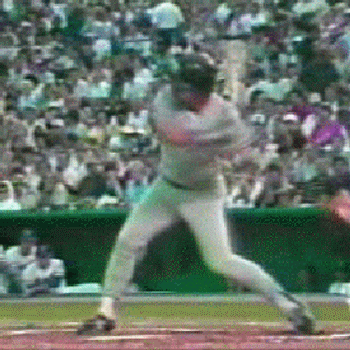
The Loop in Don Mattingly's Swing
In fact, I have literally never seen a picture or clip of a good, game swing of a good hitter where they do not have a loop in their swing.
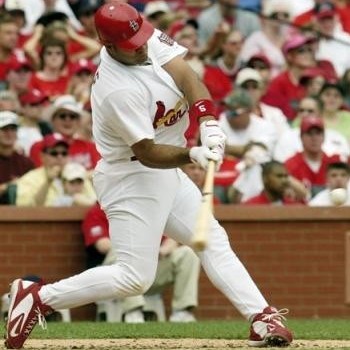
Albert Pujols
Home Run Swing
As the picture above shows, Albert Pujols has a large Loop in his swing when he hits a ball down in the strike zone. However, he still has a small Loop in his swing when he hits a ball at the top of the strike zone.

The Loop in Albert Pujols' Swing
When it come to having a Loop in one's swing, the bottom line is that -- while you certainly can uppercut too much -- a slight uppercut is nothing to worry about and is how good hitters match the plane of their swing to the plane of the pitch.
Uppercutting
Don't get me wrong; it is possible to swing with an Excessive Uppercut.
You see this problem all the time in young kids who are coming out of coach pitch and whose coaches pitched the ball at too steep of an angle (e.g. because they stood up while pitching instead of pitching from one knee). However, in many cases an Excessive Uppercut is just a symptom of another, bigger problem like Bat Drag or Dumping the Barrel.
As I explain at length in my piece on the Swing Plane, in truth every good swing is a Slight Uppercut. Anyone who thinks that an uppercut is always bad, and who uses drills that are designed to completely eliminate an uppercut, and ensure that the barrel always stays above the ball, doesn't understand what a good swing actually looks like.
Notes
[1] When I first started playing slow-pitch softball, and while I was still learning about hitting, I found that, every once in a while, I would absolutely destroy a ball if it was up and in. However, I always hit it slightly to significantly foul. In hindsight, what was going on was that I probably had a problem with casting in my swing and had to pull my hands in hard to get to that pitch. That let me hit the ball hard, but also caused me to pull-hook it.
[2] Golfers want their front arm to be straight because that will maximize the force with which they hit the ball. However, golfers can get away with this, while baseball and fast pitch softball players cannot, because they are not hitting a ball that is moving.
[3] Don Mattingly also believes a loop in the swing is a bad thing.